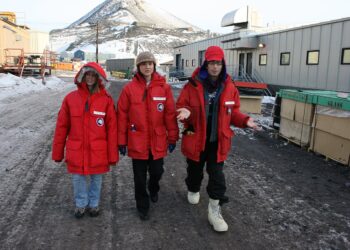
The Southern Ocean exists in a state of precarious balance. The sea is layered, with cold surface water sitting atop relatively warm water. It’s an inherently unstable situation—all else being equal, the warm water should rise to the top. But it’s saltier and therefore denser, so it lurks below. The cold upper layer, meanwhile, is freshened by snowfall and sea ice, which forms near the coast, then drifts northward into the open ocean before melting.
For the past 10 years, sea ice cover has been in decline as ocean temperatures have warmed. The rapid melting has delivered even more freshwater to the surface, which should strengthen the cold-water-layer’s insulative ability, allowing the sea ice to eventually expand again.
But that feedback loop appears to have been disrupted. New satellite data have revealed that the ocean around Antarctica, against all expectations, is getting saltier.
The study was published in Proceedings of the National Academy of Sciences of the United States of America.
Measuring Where It’s Hard to Measure
Sea ice, rough seas, and 24-hour darkness make it nearly impossible to monitor Southern Ocean salinity from a ship in the winter. Only in recent years has it been possible to measure salinity in the Southern Ocean from space. Satellites can observe the ocean surface’s brightness temperature—a measure of radiation given off at the sea surface. The fresher the water, the higher the brightness temperature.
The technique works well in warmer waters, but in cold waters, brightness temperature doesn’t shift as much as salinity changes. Because these changes are generally quite subtle to begin with, satellites haven’t been able to accurately detect them in polar regions. In these areas, sea ice has also clouded the signal.
Recent advances in satellite technology, however, have greatly improved the sensitivity of brightness readings, and new algorithms allow researchers to clean up noise from sea ice.
Oceanographer Alessandro Silvano of the University of Southampton and his colleagues analyzed the past 12 years of salinity records from the European Space Agency’s Soil Moisture and Ocean Salinity (SMOS) satellite. Team member Alex Haumann, a climate scientist with Ludwig-Maximilians-Universität München, in Germany, said having these broad data, which cover the entire Southern Ocean at 25-square-kilometer resolution, is a game changer. “Due to the big coverage and the time series you can get, it’s super valuable. It’s really a new tool to monitor this system.”
When the team saw that salinity had increased over that period, however, they couldn’t help but question the technology. To ground truth what they were seeing, they turned to Argo floats—automated buoys that sample water up to 2,000 meters deep. A network of the floats dots the world’s seas, including the Southern Ocean.
To Silvano’s surprise and shock, the floats corroborated the satellite data. “They show the same signal,” he said. “We thought, okay, this is a real thing. It’s not an error.”
Matching the salinity data to trends in sea ice, the team noticed a disturbing pattern. “There is a very high correlation between the surface salinity and the sea ice cover,” Haumann said. “Whenever there’s high salinity, you have low sea ice. Whenever it is low salinity, there is more sea ice.”
“With warming, we expect more freshwater to be flowing into the ocean. So having this saltier water appearing at the surface is quite shocking,” said Inga Smith, a sea ice physicist at the University of Otago in New Zealand who was not involved in the research.
A Shifting Regime
The most plausible explanation for the boost in salinity, Silvano said, is that the delicate layers of Antarctic water have been upset, and the warmer, saltier water below is now bursting through to the surface, making the surface too warm for sea ice to form.
Though he stressed it’s too early to pinpoint a cause for the upwelling, Silvano postulated that it may be driven by stronger westerly winds around Antarctica—a result of the warming climate. He said he fears that Antarctica’s natural damage control mechanism, in which ice melt releases freshwater, which in turn traps the warm deep water and eventually allows more sea ice to form, is now irreversibly broken.
The weakening of the ocean’s stratification instead threatens to set up a dangerous new feedback, whereby powerful convection currents bring up even more warm, salty water from depth, leading to runaway ice loss.
“We think this could be a regime shift—a shift in the ocean and ice system, where you have permanently less ice,” Silvano said.
Wolfgang Rack, a glaciologist with the University of Canterbury in New Zealand who was not involved in the research, said the satellite record is not long enough to show whether the rise in salinity is an anomaly, or a new state of normal, but “it is quite unlikely that it is a simple anomaly, because the signal is so significant.”
Zhaomin Wang, an oceanographer with Hohai University in Nanjing, China, who was not involved in the research, said the study was a “very firm result,” but cautioned that it’s still too early to conclusively pin the sea ice retreat on upwelling. “It’s quite difficult to disentangle the cause and effect between Antarctic sea ice change and the surface salinity change,” he said, “because it’s a coupled system, making it difficult to determine which process initiates the changes.”
For Haumann, the findings show how crucial new technology is for tracking changes in the Southern Ocean. “We have to find ways to monitor the system, because it’s changing very rapidly,” he said. “This is one of the most distant regions on Earth, but one of the most critical for society. Most of the excess heat we have in the climate system goes into this region, and this has helped us keep the planet at a relatively moderate warming rate.”
“Now we don’t really know what will happen to that,” he said.
This article originally appeared in EOS Magazine.






